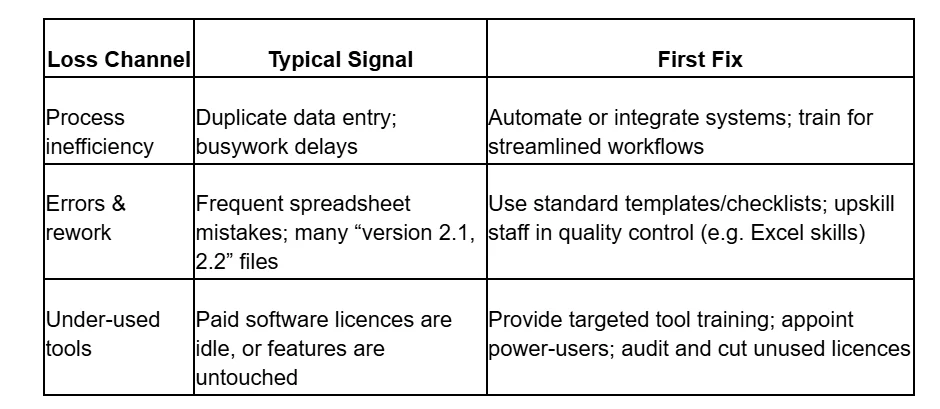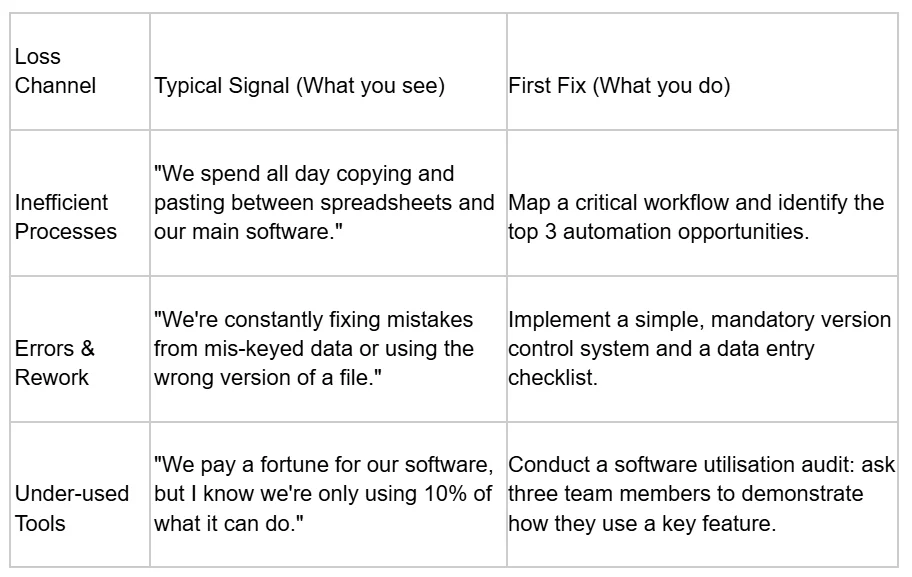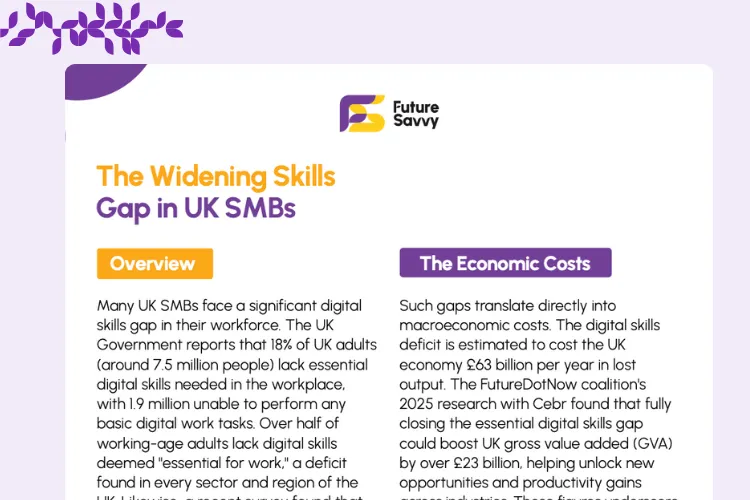- L&D INSIGHTS/
- Digital skills gap: £63bn a year hit for UK SMBs/


Digital skills gap: £63bn a year hit for UK SMBs
- L&D INSIGHTS/
- Digital skills gap: £63bn a year hit for UK SMBs/
Digital skills gap: £63bn a year hit for UK SMBs
Every year, the UK economy loses an estimated £63 billion in output due to the digital skills gap.
A single, misread email about a design change on a building site. An account manager spends an hour manually copying sales data from a spreadsheet into the company CRM. A premium software licence, paid for monthly, is sitting completely unused. These small, daily frictions seem minor in isolation.
But when aggregated across the UK’s 5.5 million small and medium-sized enterprises (SMBs), they contribute to a staggering £63 billion annual productivity drag on the national economy. Spread across the SMB workforce, this equates to roughly £3,800 in lost productivity per employee annually. In plain terms, a 50-person firm might be missing out on around £190,000 of output each year because staff lack the digital skills to work efficiently.
In this article, we break down how that £63 billion translates to the firm level, identify the everyday inefficiencies causing it, and chart a 90-day plan to start closing the gap. The goal is pragmatic and optimistic – UK SMBs can turn the digital skills gap into an opportunity for quick wins and long-term gains.
Download our White Paper: The Impact of Skills Underinvestment on UK SMBs
 Download now
Download nowBackground & Evidence
What is the “digital skills gap” for an SMB? In simple terms, it’s the gap between the skills employees have and the skills needed to fully utilise modern software, data, and processes in the business. An SMB might invest in new tools – say, a project management platform or data analytics software – but if the team isn’t trained to use them, much of that investment sits idle.
Over 18% of UK adults (around 7.5 million people) lack essential digital work skills, and many more aren’t confident beyond basic tasks. It’s no surprise, then, that 77% of UK SMB leaders feel they don’t have the skills to implement new technologies successfully. The result is a pervasive productivity gap: routine tasks take longer, errors are more frequent, and advanced tools go underused.
According to our new research, detailed in the Future Savvy White Paper, this gap manifests in three primary channels of value loss:
- Process Inefficiency: Time wasted on manual, repetitive tasks that could and should be automated.
- Errors & Rework: The direct cost of mistakes caused by poor data management, version control, and digital communication.
- Under-used Tools: The sunk cost of software licences and features that are paid for but never leveraged for productivity gains.
To summarise these loss drivers, consider the signals and quick fixes in the table below:

What the £63bn Drag Means for Your Firm
How does a £63 billion national problem break down for an individual company? Let’s do a quick back-of-the-envelope calculation.
Back-of-the-Envelope Calculator:
- Per-Employee Drag (£): £63,000,000,000 ÷16,600,000 SMB employees ≈ £3,800 lost per employee per year.
- For example, a firm with 50 employees might be losing on the order of 50 × £3,800 = £190,000 in output annually.
- Time Wasted Model: If each employee wastes just 15 minutes per day due to digital inefficiencies (struggling with outdated processes or unfamiliar software), that’s about 1¼ hours per week. At an average fully-loaded rate of ~£25/hour, it comes to roughly £1,400 per year per employee in lost value. At 30 minutes per day, the loss doubles to ~£2,800 per employee annually. These small daily inefficiencies add up fast.
Is the Digital Skills Gap Solvable?
These figures aren't meant to be exact, but they demonstrate a clear and consistent scale of loss. Whether we calculate top-down (macro loss divided by workforce) or bottom-up (minutes lost per day), we arrive at the same conclusion: the digital skills gap acts like a stealth tax on each SMB’s performance.
The core message remains: even a few minutes of inefficiency per day, multiplied across your team, carries a hefty annual price tag. By recognising this latent cost, business leaders can justify the ROI of digital upskilling. After all, if you knew £200k was leaking from your business, you’d act – the next sections show where to look for leaks and how to start plugging them.
Where the Losses Arise: The Three Hidden Drains
The losses calculated above aren't random; they flow from specific operational failures. By diagnosing them, you can start to plug the leaks.

Now let's look at each one more closely.
Inefficient Processes: The "Swivel-Chair" Tax
This is the daily grind of manual data entry and moving information between systems that don't talk to each other. Research shows salespeople spend only 28% of their week actually selling; the rest is consumed by administration. A construction worker can spend nearly half their time simply moving data between different apps.
- Micro-example: A project manager receives a client update via email, types it into a project spreadsheet, and then re-types it into a task management app for their team. Each step is a waste of time and a potential source of error.
- Fix Lever: Process mapping and targeted automation.
Errors & Rework: The Compounding Cost of Mistakes
The digital skills gap directly fuels errors. A mis-keyed number in a quote, a contract sent with the wrong client name, or a team working from an outdated drawing all create expensive rework. Poor data management alone has cost UK SMBs an estimated £5.3 billion in recovery costs and lost productivity over the past five years.
- Micro-example: A junior team member, unsure how to use the shared server's version control, saves a new version of a client proposal over the top of the final, approved one. The error is only caught after it has been sent, requiring an embarrassing retraction and correction.
- Fix Lever: Standardised data governance and digital literacy training.
Underused Tools: The "Shelfware" Epidemic
This is perhaps the most frustrating leakage:paying for potential you never use. UK businesses waste an estimated £1.7 billion a year on unused software licences. Many CRM projects, for instance, fail to deliver value because poor user adoption means they are used as little more than expensive digital address books, with powerful automation and reporting features left untouched.
- Micro-example: An accounting firm invests in a powerful reporting add-on for its main software package, but because no one is trained on how to build custom reports, the team reverts to manually exporting data to spreadsheets—the very process the software was bought to replace.
- Fix Lever: Role-based software training and regular licence audits.
From Theory to Practice: A Case Study
As detailed in the Future Savvy White Paper, tackling the digital skills gap delivers tangible returns.
Scenario: Billable Leakage From Underused Tools:
- Mid-sized accounting/consulting firm with practice management, CRM and document automation in place, but inconsistent adoption.
- Tasks/time tracked in personal spreadsheets; templates ignored; basic Excel gaps causing errors and unbillable rework.
Solution: Targeted Enablement Process Alignment:
- Six-week “digital boost” (weekly lunch-and-learns) focused on time-tracking/CRM, document automation, and advanced Excel.
- Power users demoed real workflows; managers enforced unified templates/SOPs and “no solo spreadsheets”.
Results: Measurable Productivity and Quality Gains:
- ~5% uptick in billable hours logged the next cycle; internal rework time down ≈20% as report/model errors fell.
- Analysts worked more autonomously after Excel/Power BI training; confidence and morale improved, recovering ££ each month without adding headcount.
Your 90-Day Plan to Claw Back Value
Finally, addressing the digital skills gap doesn't require a multi-year transformation programme. A focused, 90-day sprint can deliver measurable results and build the momentum for lasting change.
Days 1–30: Skills Audit
The goal is to move from guessing to knowing. Identify the 3-5 most time-consuming or error-prone workflows in your business. Map which roles, tools, and skills are involved, and use a simple survey to gauge your team's confidence. Critically, establish baseline metrics: How long does this task take now? What is the current error rate?
Days 31–60: Targeted Training & Enablement
Based on your audit, pick the 3-5 skills that will have the biggest impact. Run short, practical workshops focused on real-world tasks, not abstract software features. Appoint enthusiastic team members as "digital champions" to provide peer support and drive adoption from the ground up.
Days 61–90: ROI Tracking
Now, measure the impact. Re-run your baseline KPIs and quantify the improvement. Track software licence utilisation to ensure your investment is paying off. Finally, codify the new, more efficient process into your standard operating procedures to lock in the gains and publish a simple, one-page report to the team celebrating the value you’ve created together.
The £63 billion digital skills gap may sound daunting, but for UK SMBs it spells a huge opportunity. By breaking the problem down to the level of your firm and your people, you can see where to act – whether it’s trimming a 10-minute task down to 2 minutes with better training or finally getting full value from that software you’ve been paying for. These are achievable, often inexpensive fixes that deliver quick wins.
Read the full Future Savvy White Paper for sector-specific data, diagnostic checklists, and ROI templates to help you build your own 90-day plan.
Related Articles

White Paper: The Impact of Skills Underinvestment on UK SMBs
Uncover the real cost of skills gaps for UK SMBs. This white paper highlights the billions lost each year to underinvestment in training and shows how upskilling boosts productivity, retention, and growth.
